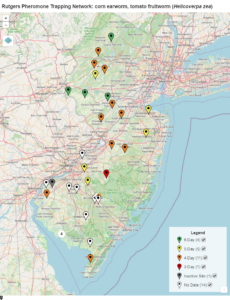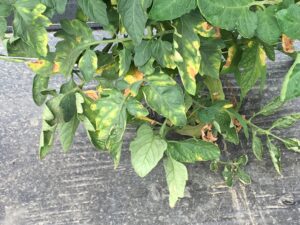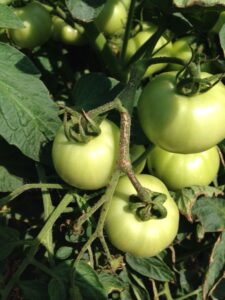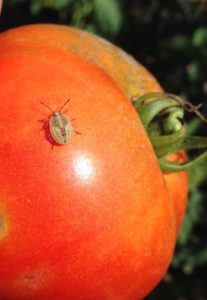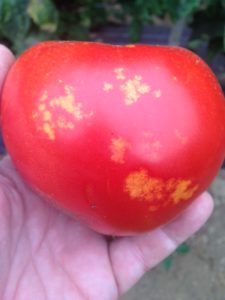Sweet Corn
European corn borer (ECB) moth catches are very low in blacklight traps in the northern and central counties. Feeding signs are largely absent from whorl and pre-tassel stage plantings.
The highest nightly trap catches of ECB for the week ending 7/03/24 are as follows:
| Clinton 1 | Milltown 1 |
| Dayton 1 | Old Bridge 1 |
| Hillsborough 1 | Oldwick 1 |
The low level fall armyworm (FAW) infestations we had found in some whorl stage corn in central NJ, have been treated and new infestations have not occurred. It is possible that some infestations remain in unmonitored fields. It is important to check short whorl plantings at least weekly for the remainder of the season because early detection and treatment limit irreversible damage to plants.
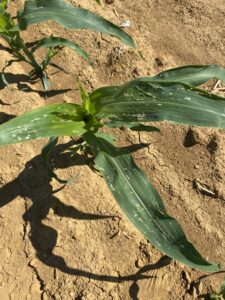 Newly hatched FAW larvae cause holes and scratches on leaves that are similar to ECB feeding, except that they tend to be more concentrated and always lead down into the whorl (see photo at left). As the larvae grow, the feeding becomes more destructive, with large ragged holes and obvious droppings deposited in the whorl (see photo at right).
Newly hatched FAW larvae cause holes and scratches on leaves that are similar to ECB feeding, except that they tend to be more concentrated and always lead down into the whorl (see photo at left). As the larvae grow, the feeding becomes more destructive, with large ragged holes and obvious droppings deposited in the whorl (see photo at right). 
We will provide updates on new FAW appearances and severity as reports come in. FAW are resistant to synthetic pyrethroids. Effective sprays should include IRAC grp. 5 (spinosyns) or IRAC grp. 28 (diamides). The carbamate (IRAC grp. 1A) Lannate is also still effective. Sufficient water should be used in the applications to allow the solution to penetrate the layer of droppings that may have formed above the caterpillar.
Corn earworm (CEW) moths captures from northern and central blacklight traps remain low, although there were light catches at more sites this past week. Pheromone trap information is available from all northern and central sites, but is limited from southern New Jersey. Pheromone catches declined over the past week. At present, a pheromone trap in lower Burlington remains the hot spot , while other pheromone traps continue to register a persistent lower population of moths (see pheromone trap may below). Typically, CEW numbers decline late in June through mid-July. We will use a combination of pheromone and blacklight trap types to derive silk spray schedules by region. Silking corn is at risk of CEW infestation at this time. Be sure to access information from this publication in the upcoming weeks to determine how frequently you should treat silking sweet corn to protect it from CEW infestation.
The highest nightly blacklight trap catches of CEW for the week ending 7/03/24 are as follows:
| Allamuchy 1 | Denville 1 | Oldwick 1 |
| Bellemeade 1 | Farmingdale 1 | Pennington 1 |
| Dayton 1 | Millown 1 | Port Murray 1 |
The highest nightly pheromone trap catches of CEW for the week ending 7/03/24 are as follows:
| Tabernacle 43 | Pennington 7 | Elm 5 |
| Allamuchy 12 | Hackettstown 6 | Georgetown 5 |
| New Egypt 10 | Dayton 10 | Green Creek 5 |
| Woodstown 10 | Chester 5 | Bellemeade 5 |
Using our current pheromone- based thresholds (30″ Hartstack trap) developed by the Univ. of Delaware, nightly corn earworm moth catches translate to:
0 moths – 6-7 day spray schedule
1 moth – 5 day spray schedule
2-20 moths – 4 day spray schedule
>20 moths – 3 day spray schedule
Silking Spray Schedules*:
South – 3-4 days
Central – 4-5 days
North – 4-5 days
*These recommendations are based on regional catches. Adhere to tighter spray schedules if indicated by local trap catches. Synthetic pyrethroids alone should NOT be used for corn earworm (CEW) protection on silking corn, or for fall armyworm (FAW) management at any stage. Control with these materials is very inconsistent.
Tomatoes
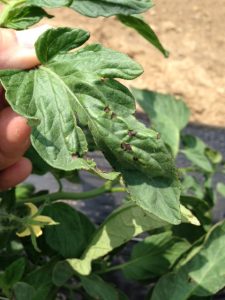 Bacterial leaf spot (BLS) and bacterial canker symptoms are beginning to appear in some scouted fields in central and northern counties. Symptoms of BLS infection include small, very dark lesions appearing on foliage of any age (see photo at left). Often even immature, unexpanded leaves are affected. Copper resistance in BLS populations in NJ has been identified. Bacterial canker is first characterized by marginal lesions on older foliage (photo below at left). These lesions work inward, ultimately killing entire leaves. Fruit lesions, also called bird’s eye spot (photo below at center) are initiated on very small fruit but become apparent as fruit enlarge. Dry lesions also may form on petioles (photo below at right). It is advisable that growers avoid working in fields when foliage is wet, to avoid easy spread of infections. Growers should also work from youngest blocks to oldest, to limit the chance of spreading disease to younger plants. Pruning, tying and harvesting are all ways that these diseases are dispersed throughout plantings. Bacterial infections in the field may be mitigated to some degree with systemic immune response activator Actigard, although results are often limited if weather and human activity favor spread. See the Tomato Section of the 2024/25 Commercial Vegetable Production Recommendations for further information.
Bacterial leaf spot (BLS) and bacterial canker symptoms are beginning to appear in some scouted fields in central and northern counties. Symptoms of BLS infection include small, very dark lesions appearing on foliage of any age (see photo at left). Often even immature, unexpanded leaves are affected. Copper resistance in BLS populations in NJ has been identified. Bacterial canker is first characterized by marginal lesions on older foliage (photo below at left). These lesions work inward, ultimately killing entire leaves. Fruit lesions, also called bird’s eye spot (photo below at center) are initiated on very small fruit but become apparent as fruit enlarge. Dry lesions also may form on petioles (photo below at right). It is advisable that growers avoid working in fields when foliage is wet, to avoid easy spread of infections. Growers should also work from youngest blocks to oldest, to limit the chance of spreading disease to younger plants. Pruning, tying and harvesting are all ways that these diseases are dispersed throughout plantings. Bacterial infections in the field may be mitigated to some degree with systemic immune response activator Actigard, although results are often limited if weather and human activity favor spread. See the Tomato Section of the 2024/25 Commercial Vegetable Production Recommendations for further information.
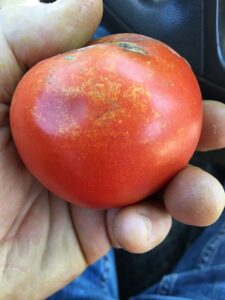 Thrips infestations are increasing in some high tunnels. Warming weather can result in field infestations in many areas. These
Thrips infestations are increasing in some high tunnels. Warming weather can result in field infestations in many areas. These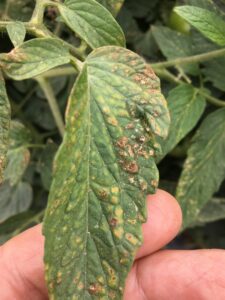 insects initially feed on foliage (see photo at right), and ultimately move to the surface of fruit, where they cause gold flecking to occur on ripening fruit (photo at left). While all “gold fleck” is not related to thrips, that which forms distinct rings and trails on fruit surfaces is caused by their feeding. Thrips can be difficult to manage due to insecticide resistance issues and their habit of hiding in blossoms and other tight spaces on the plants. It is best to apply control before populations become widespread in plantings. See the Tomato Section from the 2024-25 Guide for suggested insecticides.
insects initially feed on foliage (see photo at right), and ultimately move to the surface of fruit, where they cause gold flecking to occur on ripening fruit (photo at left). While all “gold fleck” is not related to thrips, that which forms distinct rings and trails on fruit surfaces is caused by their feeding. Thrips can be difficult to manage due to insecticide resistance issues and their habit of hiding in blossoms and other tight spaces on the plants. It is best to apply control before populations become widespread in plantings. See the Tomato Section from the 2024-25 Guide for suggested insecticides.
We are in the time of the season when native brown stink bugs become active in tomato fields. These true bugs (see photo of Euschistus sp. nymph below at left), move into irrigated tomato fields as forage in the surrounding environment dries out. Feeding results in “cloudy spot” (see photo at right below). Increases in stink bug injury are often found by crews picking the fruit. Growers should consider 1-2 insecticide applications to limit fruit injury if this damage is increasing in harvested fruit. If actively scouting fields, insecticides should be considered if stink bug adults, nymphs or new fruit injury is found in 2 or more sample sites in a 10 site sample. Insecticides that are effective on stink bugs include pyrethroids and neonicotinoids (see Tomato Section from the 2024-25 Guide), so care should be taken to avoid contact with foraging bees.
nfestations tend to be very local for unknown reasons. As with other armyworms, BAW is difficult to control with pyrethroid insecticides. Effective materials include spinosyns (IRAC 5) and diamides (IRAC 28).
Pepper Weevil – Correction – new email address
Dr. Joseph Ingerson-Mahar (Ret.) has a number of sticky cards and dowels for pepper weevil traps, and is willing to help growers obtain these components as well as lures from a supplier. Contact him for assistance in this, and with deployment of traps and identification of weevils. Dr. Ingerson-Mahar’s email is: patrobus@comcast.net
Cucurbit Downy Mildew
Cucurbit downy mildew (CDM) has been detected on cucumber in Salem County as per Dr. Andy Wyenandt’s alert of 6/19/24. All cucumber growers should monitor fields for signs of this disease. Look for chlorotic areas bordered by veins on the upper leaf surface (photo at lower right). If conditions are moist, dark sporulation may be found on the lower leaf surface (photo at lower left).
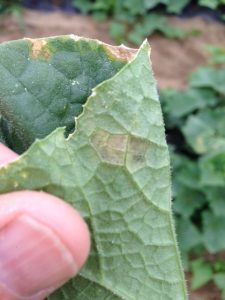
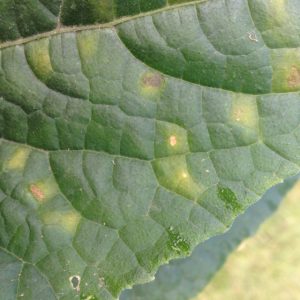 All cucumber and cantaloupe plantings should be protected. Useful materials for CDM may be found in the Cucumber Section of the 2022/23 Commercial Vegetable Production Recommendations. A sentinel plot is now established at Snyder Farm in Hunterdon County. This plot, consisting of pumpkin, watermelon, cantaloupe, butternut, acorn, cucumber and kabocha squash will be used to indicate the presence of cucurbit downy mildew in the region, and what crops are affected. As of 7/02/24, no CDM had been detected on any of these crops in the sentinel plot, nor in any scouted field in northern and central NJ. For regional information on this important disease, see the Cucurbit Downy Mildew webpage: http://cdm.ipmpipe.org/. Note that the forecast component of this site is not active. However, reports of CDM can still be found on the site, and will appear on the homepage map down to county level, with associated host information.
All cucumber and cantaloupe plantings should be protected. Useful materials for CDM may be found in the Cucumber Section of the 2022/23 Commercial Vegetable Production Recommendations. A sentinel plot is now established at Snyder Farm in Hunterdon County. This plot, consisting of pumpkin, watermelon, cantaloupe, butternut, acorn, cucumber and kabocha squash will be used to indicate the presence of cucurbit downy mildew in the region, and what crops are affected. As of 7/02/24, no CDM had been detected on any of these crops in the sentinel plot, nor in any scouted field in northern and central NJ. For regional information on this important disease, see the Cucurbit Downy Mildew webpage: http://cdm.ipmpipe.org/. Note that the forecast component of this site is not active. However, reports of CDM can still be found on the site, and will appear on the homepage map down to county level, with associated host information.
Thank you!
The Vegetable IPM Program wishes to thank the following Field Technicians, without whom much of the information presented weekly here would not be available:
Chris Cloutier
Hamna Khalid
Alexandra Suszko
